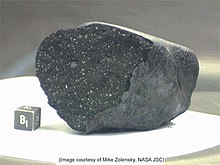Cubanite
| Cubanite | ||
|---|---|---|
Specific gravity 4.0–4.2 | | |
| Optical properties | Distinctly anisotropic on polished surface | |
| Other characteristics | Strongly magnetic | |
| References | [2][3][4] | |
Cubanite is a
Cubanite occurs in high temperature
Etymology and history

Cubanite comes from the Spanish word Cubano, or Cuban in English, and the suffix -ite, when naming a mineral. Cubanite was first described in 1843 for its occurrence in the Mayarí-Baracoa Belt, HolguÍn Province, Cuba. It may also be referenced as barracanite in some literature.[2]
Association and alteration
As a minor alteration mineral, cubanite can only form when there is hydrothermal alteration of magmatic ores. The ores that are associated with cubanite are unaltered pyrrhotite-pentlandite-chalcopyrite ores that experience alteration to millerite-pyrite-chalcopyrite-cubanite ores, like those seen in the Bushveld Complex.[7] For cubanite to form from chalcopyrite, a loss of copper relative to sulfur and iron and an increase in iron relative to sulfur must occur.[7] This significant change in mineralogy results crystal structure change from tetragonal chalcopyrite to orthorhombic cubanite. With an increase in temperature above 210 °C, alteration continues and cubanite will transform into isocubanite, an isometric polymorph. There will be no transformation back to cubanite upon the cooling of the isocubanite.[5]
Extraterrestrial cubanite

Although cubanite forms in hydrothermal mineral deposits, there are occurrences of cubanite that did not form on earth. Cubanite has been found in
Synthetic cubanite
Although synthetic and chondritic cubanite have structural variations, synthesis of cubanite still grants insight into the formation of CI-chondrites. Using a lab-based variant of hydrothermal recrystallization, temperatures between 150-200 °C, and a pH of 9, scientists were able to determine compositions needed to replicate CI-chondrite mineralogy. Experiments that began with copper + iron + sulfur, covellite + troilite, and copper + sulfur + troilite all formed cubanite. Starting with troilite instead of iron metal reinforces previous studies that sulfides on Cl-chondrites are the resultant of oxidation of troilite by hydrothermal processes.[8]
Copper isotope analysis
Due to its complex growth nature, Cubanite has been the test subject for instrumental preference in copper isotope microanalysis. It was found that ultra violet laser ablation multiple collector inductively coupled plasma mass spectrometry (UV-fs-LA-MC-ICP-MS) improves precision in respect to copper isotopes, when compared to the use of near infrared (NIR-fs-LA-MC-ICP-MS) methods.[10]

References
